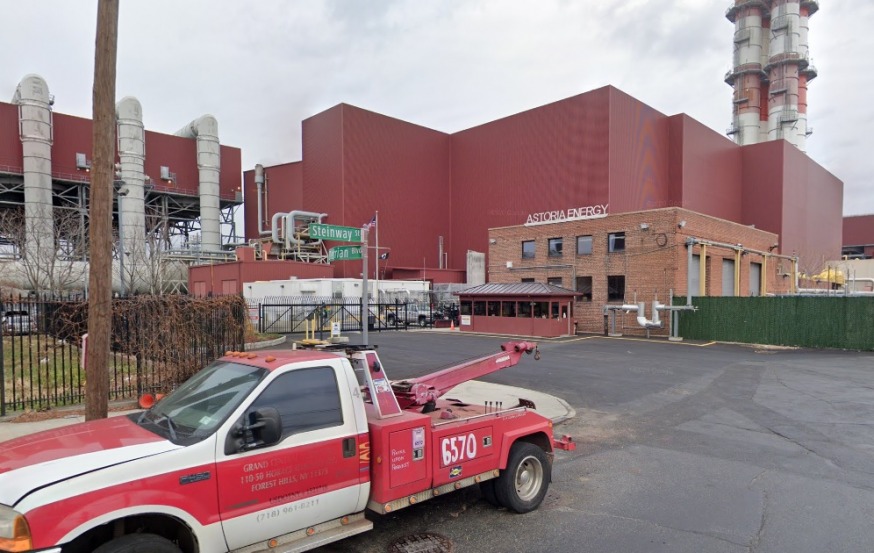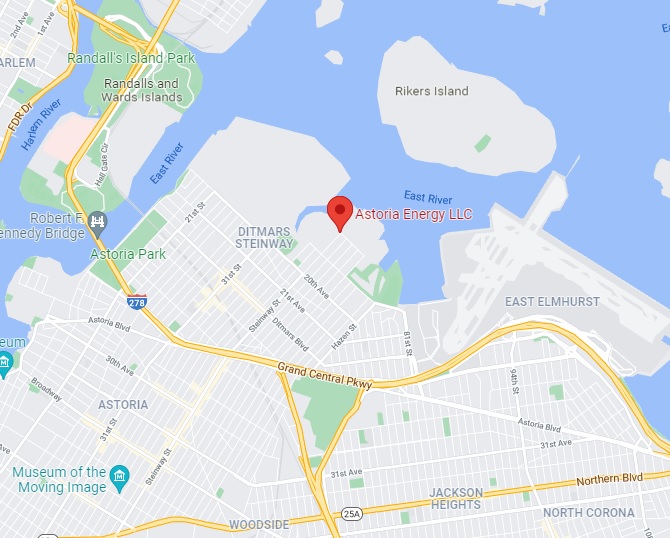
A section of the Astoria Energy Complex, which is located at the end of Steinway Street by Luyster Creek, will be transformed into an emission free converter station (GMaps)
Nov. 22, 2021 Ta’Leah Van Sistine
A portion of the Astoria Energy Complex — which had once generated power via fossil fuels — will be transformed into an emissions-free converter station through a project that was announced by Gov. Kathy Hochul in September.
The complex, located at the end of Steinway Street by Luyster Creek, will be supplied by renewable energy via the recently-announced Champlain Hudson Power Express transmission line that runs 339-miles from the U.S.-Canadian border.
The project will deliver about 1,250 megawatts, enough to power more than 1 million New York homes. The facility is likely be fully operational in 2025.

Astoria Energy Complex located at the end of Steinway Street (GMaps)
“Transitioning a former fuel oil storage facility to an emissions-free power station will … create good-paying jobs throughout New York and in Astoria (and will) provide revenue to pay for schools and community services all while improving community air quality,” a spokesperson from Transmission Developers, Inc. — the developer of the project — said in a statement.
Hydro-Québec — a public utility that manages the generation, transmission and distribution of electricity — is working with TDI on the CHPE project. Hydro-Québec owns dams in the Québec region that will supply the project with renewable hydropower.
The project is one of two selected by Gov. Hochul that focuses on energy efficiency. The other is called Clean Path NY, which will deliver clean electricity to the Rainey Substation in Long Island City, with construction expected to begin after 2024.
Details about what the Clean Path NY project involves were not provided by representatives of the project.
The two projects were selected from a list of seven submitted to the New York State Energy Research and Development Authority (NYSERDA), a state public-benefit corporation that focuses on energy efficiency. The proposals involved providing power for New York City via wind, solar and hydropower.
One of the proposals that failed to get approved by NYSERDA was the Catskills Renewable Connector project, which would have transformed Ravenswood Generating Station into a renewable energy hub.
Former New York City Council Member Costa Constantinides — while welcoming the selection of the two projects — said it was disappointing that NYSERDA didn’t take additional proposals.
“We talk about the goal of the state to be 70 percent renewable [energy generation] by 2030, which is now almost eight years away, scarily,” Constantinides said. “[The fact] that we’re turning projects away? I don’t find that to be a great paradigm. I hope that the state’s going to reconsider.”
Constantinides, however, praised the state for rejecting NRG’s proposal to rebuild its Astoria peaker plant—which would still rely on fossil fuels. The existing NRG plant will be forced to close in May 2023, since it will no longer comply with state-level restrictions on nitrogen oxide emissions.
Constantinides noted that the focus needs to be on renewable energy and that there are other projects in the works.
Equinor, a Norwegian energy giant, is developing a wind farm off the southern coast of Massachusetts that will travel 200 miles under the Long Island Sound to a substation in Astoria. That too would be about 1,250 megawatts.
Queens Borough President Donovan Richards, who also opposed the NRG project, similarly said in a statement that Queens cannot continue to rely on fossil fuels given climate change. The way the city is powered needs to change, he said.
He welcomed the CHPE project when asked.
“The project represents a tremendous investment in both the long-term sustainability of our borough and the health of our families,” Richards said. “This effort to end our fossil fuel dependency and power Queens with clean energy will … improve public health and help ensure the borough we leave for our children is not just habitable but thriving.”
The CHPE project would create 1,400 jobs throughout the state, according to officials. Once fully operational, it would meet 20 percent of New York City’s electricity needs.
The project, however, still has to undergo the review process by the New York Public Service Commission. If the approval process goes to plan, construction could begin in 2022.
4 Comments






Glad i moved. I had so many breathing problems when i lived by Ditmars.
Goodbye reliable energy! Hello rolling blackouts. NYC should have went nuclear. Cleanest, safest and most reliable. Have fun in the sweaty summers!
You’re adorable.
Great informative comment. Almost as good as NYTimes or WaPo… barely though.